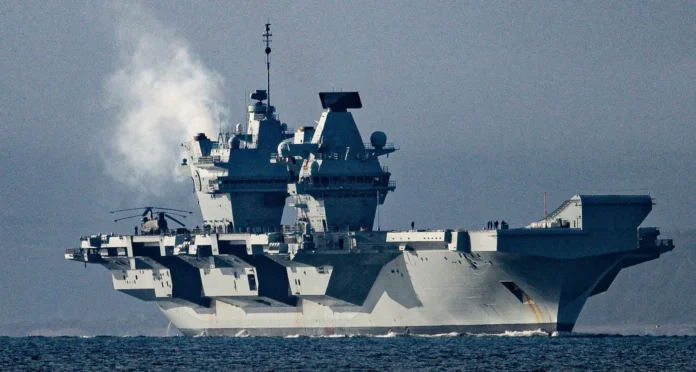A Strategic Gamble or a Necessary Commitment?
The Royal Navy is gearing up for a major deployment, but with increasing tensions in Europe and dwindling resources, is sending the UK Carrier Strike Group (CSG) to the Indo-Pacific in 2025 the right move? Or should the fleet stay closer to home, where threats from Russia continue to mount? The debate is heating up, and it’s not just about strategy, it’s about Britain’s place in the world.
The Big Picture: CSG25 and Operation HIGH MAST
The UK’s Carrier Strike Group proved its mettle in 2021, with HMS Queen Elizabeth leading a high-profile deployment that demonstrated Britain’s reach and commitment to its Indo-Pacific allies. But fast forward to 2025, and the situation has changed. The Royal Navy has shrunk in strength, costs are soaring, and Europe is facing an ever-growing threat from Russia. So, should Britain’s focus shift back to home waters?
Yet, the wheels are already in motion. The upcoming CSG25 deployment, dubbed Operation HIGH MAST, has been meticulously planned for over two years. This is no small feat. Maintenance schedules, fleet training, and operational logistics have all been synchronised to support this high-stakes mission.
HMS Prince of Wales will lead the group, with confirmed escorts HMS Dauntless and HMS Richmond, and likely contributions from another frigate and HMS Dragon. Norwegian frigate HNoMS Roald Amundsen will also join the group, carrying a British Wildcat helicopter. An Astute-class submarine will provide additional underwater capability, though it won’t always remain in the carrier’s immediate vicinity.
One crucial question remains: Will a US Navy destroyer join the deployment? In 2021, USS The Sullivans played a vital role, particularly in contested areas like the South China Sea, where its long-range missile defence capabilities were invaluable. Without a US presence, the UK’s Sea Viper air defence system may face greater challenges in such a high-threat environment.
The Challenges of Power Projection
Deploying a full-scale Carrier Strike Group isn’t just about firepower, it’s also about logistics. Support ships RFA Tidespring and Norwegian auxiliary HNoMS Maud will provide essential fuel and supplies. However, RFA Fort Victoria won’t be available, meaning the group will lack a dedicated solid stores replenishment ship. This could make resupplying at sea trickier, relying instead on helicopter transfers.
Aircraft-wise, the Royal Navy is planning to embark 24 British F-35Bs aboard HMS Prince of Wales, provided by 617 Squadron and 809 Naval Air Squadron. This is an ambitious target, given the ongoing shortages of trained pilots and engineers. Previous deployments have struggled to sustain even eight jets on a single carrier, so whether this full complement will remain throughout the deployment is uncertain.
The rest of the air group will include Merlins, Wildcats, and potentially even an RAF Chinook, providing anti-submarine warfare, maritime strike, and troop transport capabilities. Unlike the 2021 deployment, no Dutch warship will integrate into the strike group, but various allied navies will participate in joint exercises at different points.
The Red Sea Test: A Risk Worth Taking?
A major unknown in this deployment is the Red Sea leg of the journey. With tensions still simmering in the region, could the Carrier Strike Group be drawn into conflict?
Recent Houthi attacks on merchant vessels have subsided after a ceasefire in Gaza, but the group has warned that they could resume hostilities. Meanwhile, Donald Trump has ordered fresh US airstrikes on Houthi targets from USS Harry S. Truman, raising the risk of further escalation.
Some critics claim a British carrier in these waters would be a sitting duck for missile and drone strikes. However, history tells a different story. The US aircraft carrier USS Dwight D. Eisenhower operated safely in the Red Sea throughout 2024, and even the French carrier Charles de Gaulle passed through the area without incident. Despite multiple Houthi attempts, no warship has been successfully targeted.
Should the UK be afraid of deploying its flagship? Or should it be the Houthis who worry, knowing that an F-35 strike from HMS Prince of Wales could obliterate their capabilities in an instant?
The Case for Returning to the Indo-Pacific
So, why make this journey at all? What does the UK gain from sending its premier naval force halfway around the world?
The Indo-Pacific is rapidly becoming the epicentre of global power struggles. China’s growing assertiveness, particularly around Taiwan, is a major concern for allies like Japan, Australia, and South Korea. The UK’s presence reassures these nations that Britain is still a reliable security partner, reinforcing commitments made in the 2021 Integrated Review.
Diplomatically, the deployment strengthens Britain’s relationships with key players in the region, as well as with the US, whose focus is increasingly shifting towards containing China rather than defending Europe. The Carrier Strike Group isn’t just a military tool, it’s a bargaining chip. By showing commitment to the Indo-Pacific, the UK maintains influence in discussions about trade, intelligence-sharing, and military cooperation (such as AUKUS and the Five Eyes alliance).
There’s also the soft power angle. A carrier strike group isn’t just about defence, it’s an unmatched platform for promoting British industry and exports. Defence agreements like AUKUS and GCAP show how military ties translate into lucrative business opportunities.
Finally, there’s the operational value. The 2021 deployment provided invaluable experience for the Royal Navy, and a repeat mission offers another chance to test equipment and personnel in demanding, real-world conditions. This time, crew morale should also be higher, unlike in 2021, when COVID-19 restrictions robbed sailors of the chance to enjoy shore leave.
The Argument for Staying Home
On the flip side, there’s a strong argument that the Royal Navy simply can’t afford to stretch itself so thin.
Escort ships are at an all-time low, meaning fewer vessels are available for home defence. Meanwhile, Putin’s Russia remains a very real threat, especially with Trump’s wavering commitment to NATO. If the US scales back its presence in Europe, can Britain afford to send its best assets elsewhere?
There’s also the question of funding. Would the money spent on this deployment be better used plugging critical gaps in infrastructure, munitions, and equipment?
Additionally, while the Indo-Pacific deployment enhances diplomatic ties, there’s a fine line to walk. China remains a major UK trading partner. While standing firm on security matters is important, provoking Beijing too aggressively could jeopardise economic relations at a time when Britain can’t afford more financial instability.
Final Verdict: A High-Stakes Balancing Act
The CSG25 deployment is a bold move with clear advantages, it strengthens alliances, builds diplomatic leverage, and reinforces Britain’s naval presence on the world stage. However, it comes at a cost. With Europe’s security at a crossroads, some argue that the UK should be prioritising defending its own backyard rather than projecting power abroad.
Is this the right call? That remains to be seen. What is certain, however, is that this mission will be a defining moment for Britain’s military and diplomatic strategy in the years ahead.
















